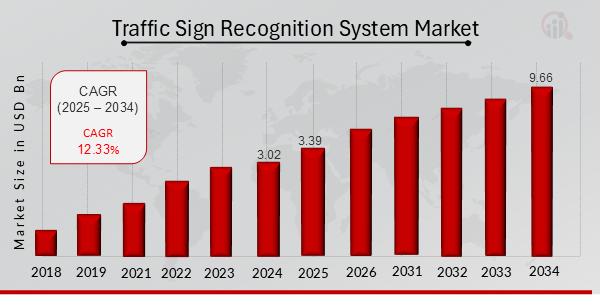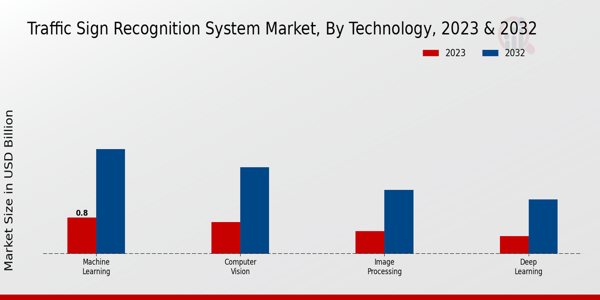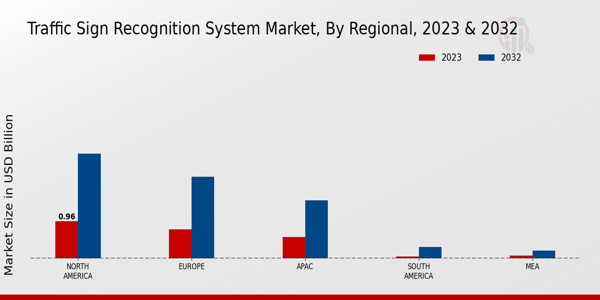Global Traffic Sign Recognition System Market Overview
As per MRFR analysis, the Traffic Sign Recognition System Market Size was estimated at 3.02 (USD Billion) in 2024. The Traffic Sign Recognition System Market Industry is expected to grow from 3.39 (USD Billion) in 2025 to 9.66 (USD Billion) till 2034, at a CAGR (growth rate) is expected to be around 12.33% during the forecast period (2025 - 2034).
Key Traffic Sign Recognition System Market Trends Highlighted
The Traffic Sign Recognition System Market is driven by an increasing focus on road safety and the implementation of advanced driver assistance systems (ADAS) in vehicles. As the number of vehicles on the road rises, so does the need for systems that can enhance safety by accurately recognizing traffic signs.
The growing popularity of autonomous vehicles also propels the demand for such systems as they rely heavily on effective communication with the driving environment. Furthermore, government regulations aimed at reducing traffic accidents and fatalities are encouraging the adoption of traffic sign recognition technology, making it a critical component in modern transportation.
As the market evolves, opportunities can be explored in the integration of artificial intelligence and machine learning algorithms to improve the accuracy and speed of recognition systems. Partnerships between technology companies and automotive manufacturers present avenues for innovative solutions to improving road safety.
There is also potential in creating systems tailored for varying geographical locales, allowing for localized adaptations in recognition capabilities. Demand for real-time data analytics in traffic systems can further open doors for advancements in this space.
Recent trends indicate a significant shift towards the development of holistic ecosystem solutions that not only recognize traffic signs but also communicate relevant information to drivers and other vehicles.
The emergence of connected vehicles is facilitating a seamless flow of information, enhancing cooperative driving scenarios. Moreover, the expansion of smart cities worldwide is prompting the need for intelligent traffic management solutions, creating a conducive environment for the growth of traffic sign recognition technology.
As cities integrate real-time data and advanced traffic management systems, the significance of traffic sign recognition becomes even more apparent, securing its role in the future of transportation.

Source: Primary Research, Secondary Research, MRFR Database and Analyst Review
Traffic Sign Recognition System Market Drivers
Increasing Demand for Autonomous Vehicles
The rise of autonomous vehicles presents a significant driving force for the Traffic Sign Recognition System Market. As the automotive industry shifts gears towards automation, the demand for advanced driver assistance systems (ADAS) has become critical.
These systems are designed to enhance vehicle safety and improve road navigation by integrating technologies that interpret and respond to traffic signs in real time. With the anticipated market growth, manufacturers are innovating to create more sophisticated recognition systems capable of accurately identifying various traffic signs under diverse conditions.
The necessity for seamless communication between vehicles and their environment feeds into the demand for robust traffic sign recognition technology. As consumers increasingly turn to automated driving solutions, investment in the Traffic Sign Recognition System Market becomes imperative as stakeholders aim to boost efficiency and reduce the likelihood of accidents.
Furthermore, regulatory bodies around the globe are focusing on establishing standards for safety and efficiency in autonomous vehicles, which boosts the development and implementation of these technologies.
The integration of artificial intelligence and machine learning also fosters advancements in traffic sign recognition systems, making them smarter and more intuitive. They can learn from exposure to different driving conditions, enhancing their ability to operate in complex environments, thus directly contributing to user trust and comfort in autonomous vehicles.
This growing trend is likely to accelerate the advancement of traffic sign recognition technologies, ensuring they meet the operational requirements of future vehicles while enhancing overall road safety.
Government Initiatives for Road Safety
Governmental bodies across the globe are increasingly focusing on road safety initiatives, which is propelling the growth of the Traffic Sign Recognition System Market. Enhanced regulations and policies are being established to improve traffic management and reduce road accidents, emphasizing the necessity for intelligent transportation systems.
Investments in infrastructure development are being channeled towards upgrading existing road signage and implementing innovative technologies that facilitate the efficient identification of traffic signs.
These governmental efforts promote the adoption of advanced traffic management systems, and as a result, organizations and manufacturers are incentivized to develop more advanced sign recognition technologies.
Technological Advancements in Machine Vision
The rapid evolution of machine vision technology is another critical driver fostering growth in the Traffic Sign Recognition System Market. With advancements in image processing, computer vision, and deep learning algorithms, machines are now capable of interpreting visual data with unprecedented accuracy.
This technological progress enables the development of highly efficient traffic sign recognition systems capable of functioning in various environmental conditions and lighting scenarios.
As the technology matures, the implementation of machine vision in vehicles becomes more feasible, translating into wider acceptance and integration of traffic sign recognition systems in automotive applications.
Traffic Sign Recognition System Market Segment Insights
Traffic Sign Recognition System Market Technology Insights
The growth is largely driven by advancements in technology, which is vital in enhancing the efficacy and accuracy of traffic sign recognition systems. The market segmentation illustrates the diverse technological approaches adopted across the sector, with Machine Learning, Computer Vision, Image Processing, and Deep Learning playing crucial roles.
Among these, the Machine Learning segment held a predominant market share, valued at 0.8 USD Billion in 2023 and expected to expand to 2.3 USD Billion by 2032. Its ability to analyze and interpret large datasets effectively enables systems to recognize traffic signs with an increased level of accuracy, making it a significant contributor to the overall market.
Computer Vision followed as another essential segment, with a valuation of 0.7 USD Billion in 2023, anticipated to reach 1.9 USD Billion in 2032. This technology enhances the ability of systems to interpret visual data from the environment, providing real-time feedback to drivers and thereby improving road safety.
Furthermore, Image Processing technology was integral in enhancing image quality and adapting to various lighting conditions for better traffic sign recognition. Initially valued at 0.5 USD Billion in 2023, it is set to grow to 1.4 USD Billion by 2032.
Though it held a smaller market share than Machine Learning and Computer Vision, its role is also pivotal in refining data inputs for more accurate recognition outcomes.
Lastly, the Deep Learning segment, while valued at 0.39 USD Billion in 2023 and projected to grow to 1.2 USD Billion by 2032, is rapidly gaining importance as it mimics human cognitive processes, thus enhancing the system's overall performance.
This growth across the Technology segment is fueled by the increasing focus on road safety, regulatory standards for automated driving systems, and innovations in artificial intelligence. However, challenges such as the high cost of implementation and the need for continuous software updates remain, potentially restraining faster adoption rates in some regions.
Overall, while each technological approach contributes to the Traffic Sign Recognition System Market, Machine Learning and Computer Vision emerge as major players, warranting significant attention regarding development and investment.
The segmentation into these specific technologies underscores the industry's trajectory towards increasingly sophisticated systems that promise to enhance vehicular safety and intelligent traffic management solutions.

Source: Primary Research, Secondary Research, MRFR Database and Analyst Review
Traffic Sign Recognition System Market Component Insights
The growth can be attributed to various components such as Cameras, Software, Sensors, and Processors, each playing a critical role in enhancing traffic sign detection and recognition capabilities. Cameras, for instance, are essential for capturing real-time images of road signs, serving as the primary input for the system.
Software translates these images into actionable data, ensuring efficient interpretation. Sensors are vital for collecting environmental data, which aids in accurate recognition under varied conditions.
Processors are crucial as they handle data processing, enabling quick responses. The increasing focus on road safety and autonomous driving technologies contributes to the demand for these components, driving significant advancements in the Traffic Sign Recognition System Market.
As urbanization continues and the need for intelligent transport systems grows, the importance of these components and their respective integration and functionality become more evident in the overall market landscape. Market trends indicate that the rising adoption of innovative technologies will foster opportunities for expansion within this sector.
Traffic Sign Recognition System Market Application Insights
The applications in this market encompass Automotive, Transportation Infrastructure, Smart Cities, and Fleet Management, each contributing uniquely to market dynamics. The Automotive segment plays a crucial role by enhancing driver safety and automating vehicle responses to road signs, promoting its rapid growth.
Transportation Infrastructure also remains significant, as the integration of smart signage with recognition systems improves traffic management and safety on roads. Additionally, Smart Cities leverage traffic sign recognition to optimize urban mobility and enhance the overall quality of life for residents, driving innovative solutions within this context.
Fleet Management, on the other hand, benefits from improved route compliance and operational efficiency, which are essential for cost-saving measures.
The anticipated growth in these applications underscores the importance of technological advancements and urban planning initiatives aimed at improving safety and efficiency within the transportation sector, further supported by favorable market trends and increasing investments in smart technologies.
Traffic Sign Recognition System Market End Use Insights
The Traffic Sign Recognition System Market has demonstrated notable growth in its End Use segment, which encompasses various categories such as Passenger Vehicles, Commercial Vehicles, and Public Transport.
Passenger vehicles significantly dominate the market, driven by consumer preferences for enhanced safety features and automated functionalities. Commercial vehicles, on the other hand, are gaining traction due to stringent regulations regarding road safety and the need for fleet management solutions.
Public transport is also emerging as a key area, offering opportunities for improving passenger safety and operational efficiency. Each of these sectors contributes uniquely to the market growth, influenced by factors such as technological advancements, increased urbanization, and shifting consumer behavior towards smart transportation solutions.
This diverse segmentation highlights the Traffic Sign Recognition System Market's robust potential and underscores the importance of these categories in addressing contemporary road safety challenges. With the expected market growth, stakeholders are looking to capitalize on innovations within each segment, making it an exciting space for future developments.
Traffic Sign Recognition System Market Regional Insights
North America led the market with a notable valuation of 0.96 USD Billion in 2023, reflecting a focus on advanced technologies and stringent traffic regulations, which bolsters its majority holding in the market. Europe followed with a valuation of 0.75 USD Billion, where strong investments in smart city initiatives drive market growth.
The APAC region, valued at 0.55 USD Billion, was rapidly growing due to increasing urbanization and the rise of smart transportation solutions.
South America, with a valuation of 0.05 USD Billion, and the MEA region, at 0.08 USD Billion, represented smaller markets but are poised for growth as governments prioritized road safety and traffic management solutions.
The Traffic Sign Recognition System Market statistics show that regional dynamics greatly influence market trends, with North America and Europe dominating due to their technological advancements, while regions like APAC are catching up owing to demographic trends favoring infrastructure development.

Source: Primary Research, Secondary Research, MRFR Database and Analyst Review
Traffic Sign Recognition System Market Key Players and Competitive Insights
The Traffic Sign Recognition System Market has been experiencing substantial growth, driven by advancements in artificial intelligence and computer vision technologies that enhance vehicle safety and improve driver assistance systems.
This evolving market is inhabited by various players who are innovating to capture a larger share through the development of intelligent traffic sign recognition systems integrated with advanced driver assistance systems (ADAS) and autonomous vehicles.
As competition intensifies, features such as accuracy, processing speed, and integration capabilities are gaining importance among manufacturers, aiming to differentiate their offerings and meet emerging regulatory and consumer demand for safety solutions.
Robert Bosch stands out within the Traffic Sign Recognition System Market due to its extensive research and development capabilities and a broad range of products that integrate seamlessly with various vehicle systems.
The company's commitment to innovation is evident in its advanced technologies for recognizing traffic signs, as it utilizes a combination of machine learning algorithms and high-quality imaging sensors.
Robert Bosch's strong partnerships with automobile manufacturers enhance its market presence, enabling the company to tailor its solutions to specific customer needs and regulatory requirements. Moreover, its established reputation for reliability and quality in automotive components further solidifies its competitive positioning in this niche market.
Harman is also a significant player in the Traffic Sign Recognition System Market, focusing on enhancing in-vehicle experiences through smart technologies. The company's expertise in audio and multimedia systems gives it a unique edge in integrating traffic sign recognition functionalities that complement driver information systems and infotainment platforms.
Harman utilizes advanced image processing techniques and artificial intelligence to improve the accuracy and efficiency of its traffic sign recognition systems, which are designed to support drivers in making informed decisions on the road.
Additionally, Harman's commitment to user-friendly interfaces and seamless connectivity enhances its appeal to a diverse range of manufacturers looking to equip their vehicles with cutting-edge safety features.
Key Companies in the Traffic Sign Recognition System Market Include
- Robert Bosch
- Harman
- NVIDIA
- Ford Motor Company
- Mobileye
- ZF Friedrichshafen
- Fujitsu
- Cohda Wireless
- Denso
- Toyota Motor Corporation
- Continental
- Tesla
- Honda Motor Co
- Waymo
- Aptiv
Traffic Sign Recognition System Market Developments
The Traffic Sign Recognition System Market has seen significant developments recently, with key players like Robert Bosch, Harman, and NVIDIA investing heavily in advanced technologies for enhancing autonomous driving capabilities.
Ford Motor Company and Mobileye are also collaborating on new AI-driven systems to improve traffic sign identification accuracy under varying conditions. ZF Friedrichshafen has expanded its portfolio focused on traffic management solutions, aligning with the growing demand for smart city infrastructure.
Fujitsu and Cohda Wireless are reportedly working on innovative solutions combining V2X (Vehicle-to-Everything) communications with traffic sign recognition for better road safety. Additionally, Denso and Toyota Motor Corporation are strengthening their partnership to develop next-generation traffic incident detection systems.
In terms of market valuation growth, the increasing emphasis on automotive safety features and the integration of machine learning models have led to a projected rise in the traffic sign recognition system segment. Companies like Continental, Tesla, and Honda Motor Co. are continuously enhancing their systems, contributing to the overall expansion of market interest.
Recent merger and acquisition moves, although limited, have hinted at strategic alignments, such as Aptiv’s acquisition of key technology firms to bolster their capabilities in traffic sign recognition solutions.
Traffic Sign Recognition System Market Segmentation Insights
-
Traffic Sign Recognition System Market Technology Outlook
- Machine Learning
- Computer Vision
- Image Processing
- Deep Learning
-
Traffic Sign Recognition System Market Component Outlook
- Cameras
- Software
- Sensors
- Processors
-
Traffic Sign Recognition System Market Application Outlook
- Automotive
- Transportation Infrastructure
- Smart Cities
- Fleet Management
-
Traffic Sign Recognition System Market End Use Outlook
- Passenger Vehicles
- Commercial Vehicles
- Public Transport
-
Traffic Sign Recognition System Market Regional Outlook
-
North America
-
Europe
-
South America
-
Asia Pacific
-
Middle East and Africa
| Report Attribute/Metric |
Details |
|
Market Size 2024
|
3.02 (USD Billion)
|
|
Market Size 2025
|
3.39 (USD Billion)
|
|
Market Size 2034
|
9.66 (USD Billion)
|
|
Compound Annual Growth Rate (CAGR)
|
12.33% (2025 - 2034)
|
|
Report Coverage
|
Revenue Forecast, Competitive Landscape, Growth Factors, and Trends
|
|
Base Year
|
2024
|
|
Market Forecast Period
|
2025 - 2034
|
|
Historical Data
|
2019 - 2023
|
| Market Forecast Units |
USD Billion |
| Key Companies Profiled |
Robert Bosch, Harman, NVIDIA, Ford Motor Company, Mobileye, ZF Friedrichshafen, Fujitsu, Cohda Wireless, Denso, Toyota Motor Corporation, Continental, Tesla, Honda Motor Co, Waymo, Aptiv |
| Segments Covered |
Technology, Component, Application, End Use, Regional |
| Key Market Opportunities |
Integration with autonomous vehicles, Expansion in smart city projects, Adoption of advanced AI technologies, Demand for real-time traffic data, Growing focus on road safety measures |
| Key Market Dynamics |
Increasing road safety regulations, Advancements in AI technology, Growth in autonomous vehicles, Rising demand for smart cities, Integration with vehicle systems |
| Countries Covered |
North America, Europe, APAC, South America, MEA |
Frequently Asked Questions (FAQ) :
The projected market size of the Traffic Sign Recognition System Market in 2034 is expected to reach 9.66 USD Billion.
The expected CAGR for the Traffic Sign Recognition System Market from 2024 to 2032 is 12.33%.
In 2034, North America is expected to have the highest market value, projected at 2.7 USD Billion.
Key players in the market include Robert Bosch, Harman, NVIDIA, Ford Motor Company, and Mobileye.
The market value of the Machine Learning technology segment in 2032 is projected to be 2.3 USD Billion.
The market value for the Computer Vision technology segment in 2032 is expected to be 1.9 USD Billion.
The projected market value for the Deep Learning technology segment in 2032 is estimated at 1.2 USD Billion.
The expected market value for the South America region in 2032 is projected to be 0.3 USD Billion.
The expected growth drivers include advancements in machine learning algorithms and increasing demand for safety features in vehicles.
The market value for the Image Processing technology segment is expected to increase to 1.4 USD Billion by 2032.

















